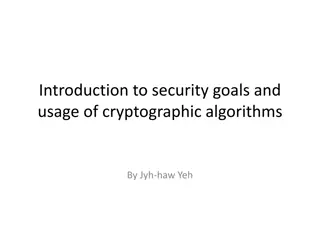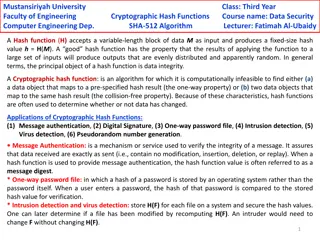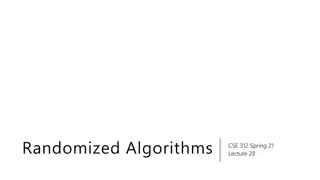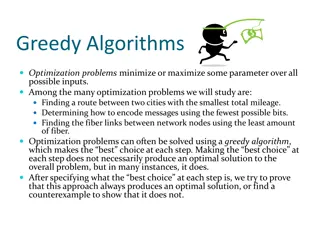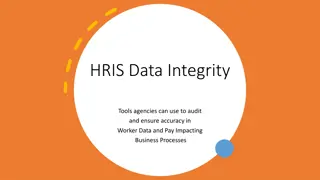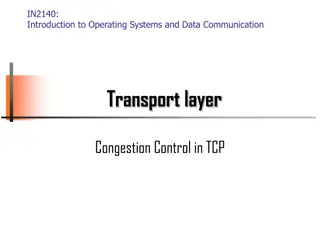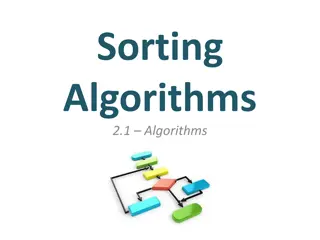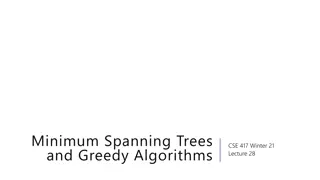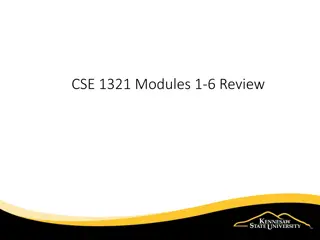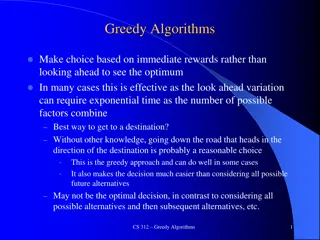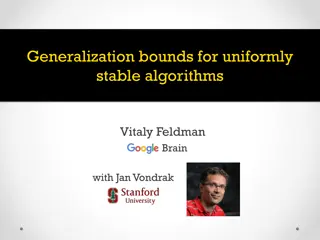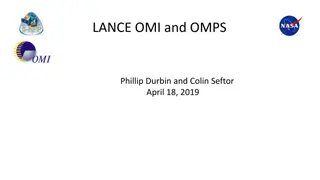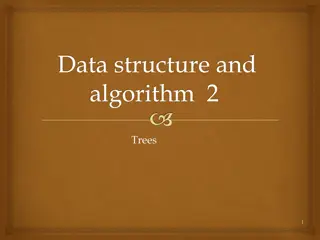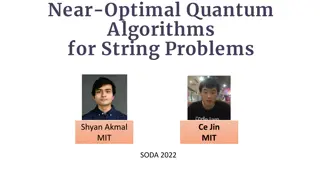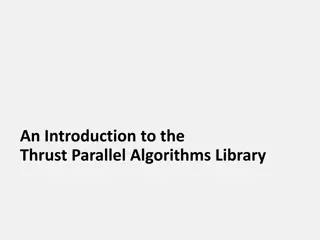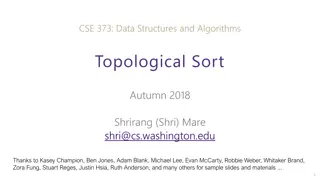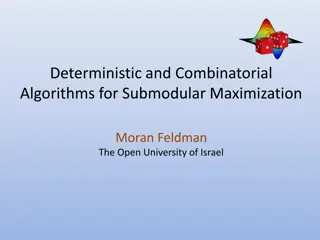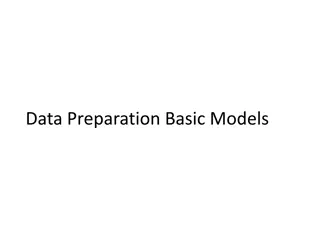Understanding Cryptographic Data Integrity Algorithms
Cryptographic data integrity algorithms ensure data integrity, verifying data received matches what was sent by authorized entities. Cryptographic hash functions play a crucial role in ensuring data integrity through hash values. Applications include message authentication, digital signatures, and various security protocols.
Download Presentation

Please find below an Image/Link to download the presentation.
The content on the website is provided AS IS for your information and personal use only. It may not be sold, licensed, or shared on other websites without obtaining consent from the author. Download presentation by click this link. If you encounter any issues during the download, it is possible that the publisher has removed the file from their server.
E N D
Presentation Transcript
Cryptographic Data Integrity Algorithms
Data Integrity Data Integrity A variety of mechanisms used to assure the integrity of a data unit or stream of data units. Ensure that data received is as sent by an authorized entity. Data integrity and data security are related terms, each playing an important role in the successful achievement of the other. Data security refers to the protection of data against unauthorized access or corruption and is necessary to ensure data integrity. Data can be compared to a hash value to determine its integrity.
Cryptographic Hash Functions A hash function H accepts a variable-length block of data M as input and produces a fixed-size hash value h = H(M) In general terms, the principal object of a hash function is data integrity. A change to any bit or bits in M results, with high probability, in a change to the hash code.
The kind of hash function needed for security applications is referred to as a cryptographic hash function. A cryptographic hash function is an algorithm for which it is computationally infeasible Hash functions are often used to determine whether or not data has changed.
Applications of Cryptographic Hash Functions Perhaps the most versatile cryptographic algorithm is the cryptographic hash function. It is used in a wide variety of security applications and Internet protocols. Such as: MessageAuthentication Digital Signatures OtherApplications: o to create a one-way password file, o intrusion detection and virus detection pseudorandom function (PRF) o to construct a or a pseudorandom number generator (PRNG)
Message Authentication Message authentication is a mechanism or service used to verify the integrity of a message. Message authentication assures that data received are exactly as sent (i.e., no modification, insertion, deletion, or replay). In many cases, there is a requirement that the authentication mechanism assures that purported identity of the sender is valid. When a hash function is used to provide message authentication, the hash function value is often referred to as a message digest.
The use of a hash function for message authentication is as follows: 1. The sender computes a hash value as a function of the bits in the message and transmits both the hash value and the message. 2. The receiver performs the same hash calculation on the message bits and compares this value with the incoming hash value. If there is a mismatch, the receiver knows that the message (or possibly the hash value) has been altered.
The hash function must be transmitted in a secure fashion. That is, the hash function must be protected so that if an adversary alters or replaces the message, it is not feasible for adversary to also alter the hash value to fool the receiver. This type of attack is shown in the following example. 1. Alice transmits a data block and attaches a hash value. 2. Darth intercepts the message, alters or replaces the data block, and calculates and attaches a new hash value. 3. Bob receives the altered data with the new hash value and does not detect the change. 4. To prevent this attack, the hash value generated by Alice must be protected.
There are a variety of ways in which a hash code can be used to provide message authentication, as follows: Message plus concatenated hash code is encrypted using symmetric encryption. Because only A and B share the secret key, the message must have come from A and has not been altered. Hash code provides the required to achieve authentication. Because encryption is applied to the entire message plus hash code, confidentiality is also provided.
Only the hash code is encrypted, using symmetric encryption. This reduces the processing burden for those applications that do not require confidentiality.
It is possible to use a hash function but no encryption for message authentication. The technique assumes that the two communicating parties share a common secret value S. A computes the hash value over the concatenation of M and S and appends the resulting hash value to M. Because B possesses S, it can recompute the hash value to verify. Because the secret value itself is not sent, an opponent cannot modify an intercepted message and cannot generate a false message.
Confidentiality can be added to the approach of method (c) by encrypting the entire message plus the hash code.
Digital Signatures Another important application, which is similar to the message authentication application, is the digital signature. In the operation of the digital signature, the hash value of a message is encrypted with a user s private key. Anyone who knows the user s public key can verify the integrity of the message that is associated with the digital signature. In this case, an attacker who wishes to alter the message would need to know the user s private key.
A simplified example on how a hash code is used to provide a digital signature is shown in next two figures. The hash code is encrypted, using public-key encryption with the sender s private key. This provides authentication. It also provides a digital signature, because only the sender could have produced the encrypted hash code. In fact, this is the essence of the digital signature technique.
If confidentiality as well as a digital signature is desired, then the message plus the private-key-encrypted hash code can be encrypted using a symmetric secret key. This is a common technique
Secure Hash Algorithm (SHA) In recent years, the most widely used hash function has been the Secure HashAlgorithm (SHA). SHA-1 produces a hash value of 160 bits. Three new versions of SHA, with hash value lengths of 256, 384, and 512 bits, known as SHA-256, SHA-384, and SHA- 512, respectively. Collectively, these hash algorithms are known as SHA-2.
SHA-512 Logic In this section, we provide a description of SHA-512. The other versions are quite similar. The algorithm takes as input a message with a maximum length of less than 2128bits and produces as output a 512-bit message digest. The input is processed in 1024-bit blocks. The processing consists of the following steps:
Step 1Append padding bits: The message is padded so that its length is congruent to 896 modulo 1024 [length 896(mod 1024)]. Padding is always added, even if the message is already of the desired length. (number of padding bits is in the range of 1 to 1024). The padding consists of a single 1 bit followed by the necessary number of 0 bits. Step 2Append length. Ablock of 128 bits is appended to the message. This block is treated as an unsigned 128-bit integer (most significant byte first) and contains the length of the original message (before the padding).
The outcome of the first two steps yields a message that is an integer multiple of 1024 bits in length. The expanded message is represented as the sequence of 1024- bit blocks M1, M2, , MN, so that the total length of the expanded message is N * 1024bits. 128+896(mod 1024) = 128+896 + (N-1)*1024 = N*1024
Step 3 Initialize hash buffer: A 512-bit buffer is used to hold intermediate and final results of the hash function. The buffer is represented as eight 64-bit registers (a, b, c, d, e, f, g, h). These registers are initialized to the following 64-bit integers (hexadecimal values): a = 6A09E667F3BCC908 e = 510E527FADE682D1 b = BB67AE8584CAA73B f = 9B05688C2B3E6C1F c = 3C6EF372FE94F82B g = 1F83D9ABFB41BD6B d =A54FF53A5F1D36F1 h = 5BE0CD19137E2179 These words were obtained by taking the first sixty-four bits of the fractional parts of the square roots of the first eight prime numbers.
Step 4 Process message in 1024-bit (128-word) blocks: The heart of the algorithm is a module that consists of 80 rounds; this module is labeled F in figure. + = word-by-word addition mod 264 Message Digest Generation Using SHA-512
The logic of step 4 is as illustrated: 1. Each round takes as input the 512-bit buffer value, abcdefgh, and updates the contents of the buffer. 1.1 At input to the first round, the buffer has the value of the intermediate hash value, Hi-1. SHA-512 Processing of a Single 1024-Bit Block
2. Each round t makes use of a 64-bit value Wt, derived from the current 1024-bit block being processed (Mi). These values are derived using a message schedule. 3. Each round also makes use of an additive constant Kt, where 0 t 79 indicates one of the 80 rounds. 3.1 These words represent the first 64 bits of the fractional parts of the cube roots of the first 80 prime numbers. 3first 64 bits of the fractional parts of the first 80 prime numbers ??= 3.2 The constants provide a randomized set of 64-bit patterns, which should eliminate any regularities in the input data. The next Table shows these constants in hexadecimal format (from left to right).
4. The output of the eightieth round is added to the input to the first round (Hi-1) to produce Hi. 5. The addition is done independently for each of the eight words in the buffer with each of the corresponding words in Hi-1, using addition modulo 264. Step 5 Output: After all N 1024-bit blocks have been processed, the output from the Nth stage is the 512-bit message digest.
We can summarize the behavior of SHA-512 as follows: H0= IV 2first sixty four bits of the fractional parts of the first eight prime numbers Hi= SUM64(Hi-1, abcdefghi) MD = HN (final message digest value) where IV = initial value of the abcdefgh buffer, defined in step 3 abcdefghi= the output of the last round of processing of the ith message block N = the number of blocks in the message (including padding and length fields) SUM64= addition modulo 264performed separately on each word of the pair of inputs
SHA-512 Round Function Let us look in more detail at the logic in each of the 80 steps of the processing of one 512-bit block. Each round is defined by the following set of equations: T2 T1
where t Ch(e, f, g) = (eAND f) (NOT eAND g) the conditional function: If e then f else g Maj(a, b, c) = (aAND b) (aAND c) (bAND c) the function is true only of the majority (two or three) of the arguments are true ( 0512a ) = ROTR28(a) ROTR34(a) ROTR39(a) ( 1512e) = ROTR14(e) ROTR18(e) ROTR41(e) ROTRn(x) = circular right shift (rotation) of the 64-bit argument x by n bits Wt = a 64-bit word derived from the current 1024-bit input block Kt = a 64-bit additive constant + = addition modulo 264 = step number; 0 t 79
Two observations can be made about the round function. 1. Six of the eight words of the output of the round function involve simply permutation (b, c, d, f, g, h) by means of rotation. This is indicated by shading in the above Figure. 2. Only two of the output words (a, e) are generated by substitution. Word e is a function of input variables (d, e, f, g, h), as well as the round word Wtand the constant Kt. Word a is a function of all of the input variables except d, as well as the round word Wtand the constant Kt.
How the 64-bit word values Wtare derived from the 1024-bit message (Creation of 80-word Input Sequence for SHA-512 Processing of Single Block) The first 16 values of Wt(W0-W15) are taken directly from the 16 words of the current block.
Example: Hash a one-block message consisting of three ASCII characters: abc, which is equivalent to the following 24-bit binary string: 01100001 01100010 01100011 1. the message is padded to a length congruent to 896 modulo 1024. 2. In this case of a single block, the padding consists of 896 - 24 = 872bits, consisting of a 1 bit followed by 871 0 bits. 3. Then a 128-bit length value is appended to the message, which contains the length of the original message (before the padding). 4. The original length is 24 bits, or a hexadecimal value of 18. 5. Putting this all together, the 1024-bit message block, in hexadecimal, is
This block is assigned to the words W0, c,W15 of the message schedule, which appears as follows.
The eight 64-bit variables, a through h, are initialized to values H0,0 through H0,7. The following table shows the initial values of these variables and their values after each of the first two rounds.
Note that in each of the rounds, six of the variables are copied directly from variables from the preceding round. The process continues through 80 rounds. The output of the final round is
Problem: State the value of the padding field in SHA-512 if the length of the message is a. 1919 bits b. 1920 bits c. 1921 bits
Problem: State the value of the padding field in SHA-512 if the length of the message is a. 1919 bits b. 1920 bits c. 1921 bits Answer: a. (1919-1024) = 895 padding 1 bit b. (1920-1024) = 896 padding 1024 bit c. (1921-1024) = 897 padding 1023 bit


